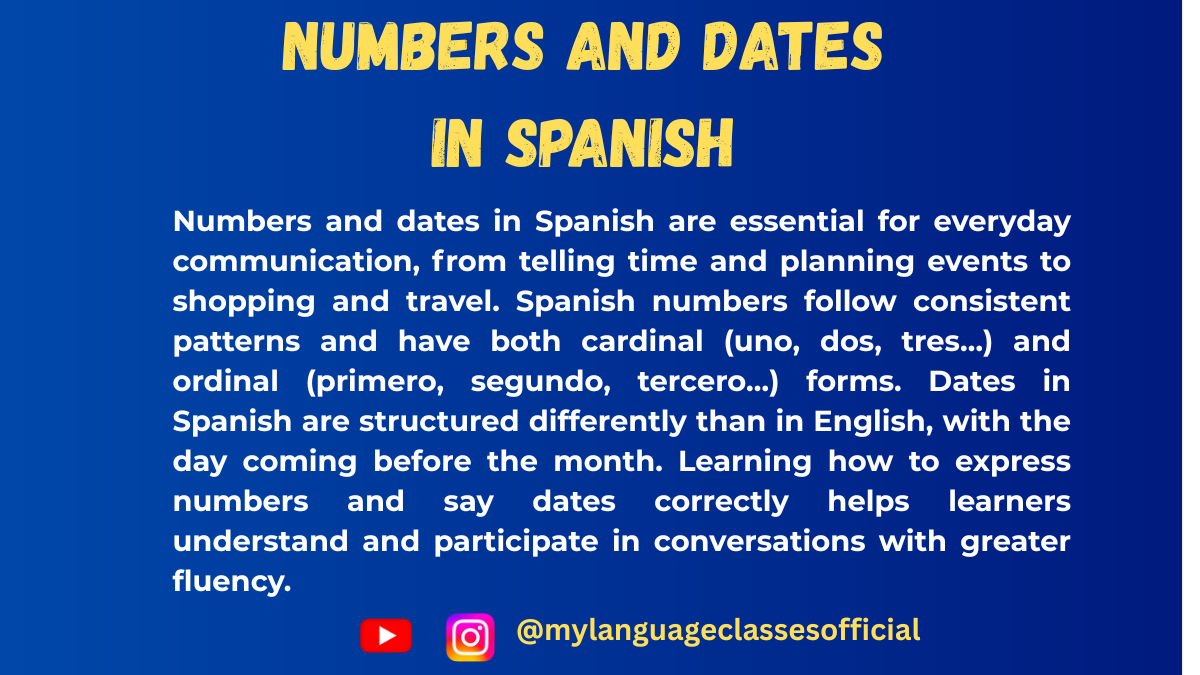Your cart is currently empty!
Tag: Spanish numbers 1 to 100 with pronunciation
-

Spanish Numbers and Dates
Spanish Numbers and Dates
Learning numbers and dates in Spanish is essential for mastering the language, as they are used daily for everything from making appointments to discussing history. In this blog post, we’ll explore the basics of Spanish numbers and dates, along with tips to practice and use them effectively.
Spanish Numbers: The Basics
Cardinal Numbers
Cardinal numbers (números cardinales) are the most basic form of numbers, used for counting. Here’s a quick overview of the key milestones:- 0-10: Cero, uno, dos, tres, cuatro, cinco, seis, siete, ocho, nueve, diez
- 11-19: Once, doce, trece, catorce, quince, dieciséis, diecisiete, dieciocho, diecinueve
- Tens (20-90): Veinte, treinta, cuarenta, cincuenta, sesenta, setenta, ochenta, noventa
- Hundreds and beyond: Cien (100), doscientos (200), mil (1,000), un millón (1,000,000)
Key Tips for Numbers:
- Pronunciation Practice: Numbers like “cinco” (five) and “siete” (seven) can trip up non-native speakers. Practice listening and repeating them to get the rhythm right.
- Connector for Numbers Over 30: Spanish uses “y” (and) to connect tens and units, e.g., treinta y cinco (35). However, numbers below 30 are written as a single word, like veintidós (22).
Dates in Spanish
Understanding how to talk about dates is vital for everyday conversations. The structure differs slightly from English, so let’s break it down.
The Format
In Spanish, the day comes before the month:
DD/MM/YYYY
For example: 15 de marzo de 2024 (March 15, 2024)Months of the Year
Enero (January), febrero (February), marzo (March), abril (April), mayo (May), junio (June), julio (July), agosto (August), septiembre (September), octubre (October), noviembre (November), diciembre (December)Days of the Week
Lunes (Monday), martes (Tuesday), miércoles (Wednesday), jueves (Thursday), viernes (Friday), sábado (Saturday), domingo (Sunday)Key Tips for Dates:
- Ordinal Numbers: Only use ordinal numbers (e.g., primero for “first”) for the first day of the month. For example, el primero de enero (January 1st). All other days use cardinal numbers: el dos de enero (January 2nd).
- Prepositions: Use de to indicate “of” when saying the full date: el 5 de mayo de 2023.
Practice Makes Perfect
To solidify your understanding of numbers and dates in Spanish, here are some fun activities to try:
- Practice with a Calendar: Choose a calendar in Spanish and try saying the dates aloud.
- Role-Playing Scenarios: Pretend to make appointments or book trips. For example, “¿Qué fecha es hoy?” (“What date is it today?”) or “Mi cumpleaños es el 10 de octubre” (“My birthday is October 10th”).
- Listening Practice: Watch Spanish-language videos or listen to podcasts where dates and numbers are mentioned. Pay close attention to how native speakers pronounce them.
Common Mistakes to Avoid
- Mixing Up Dates: Remember that “3/12/2024” in Spanish means December 3, 2024, not March 12.
- Mispronunciation of Compound Numbers: For example, veintidós (22) is often mispronounced because learners forget the stress on the final syllable.
Learning numbers and dates in Spanish is a rewarding step toward fluency. With consistent practice and attention to the nuances of pronunciation and structure, you’ll be able to confidently use these essential tools in your everyday Spanish conversations. ¡Buena suerte! (Good luck!)
What challenges have you faced with Spanish numbers and dates? Share your experiences in the comments below!
If you found this guide helpful, I’d love to hear from you! Share your thoughts in the comments below or connect with me on social media. For more tips, resources, and inspiration, visit my blog at mylanguageclasses.in. Follow on Instagram and subscribe on YouTube
📚 Continue Learning Spanish
